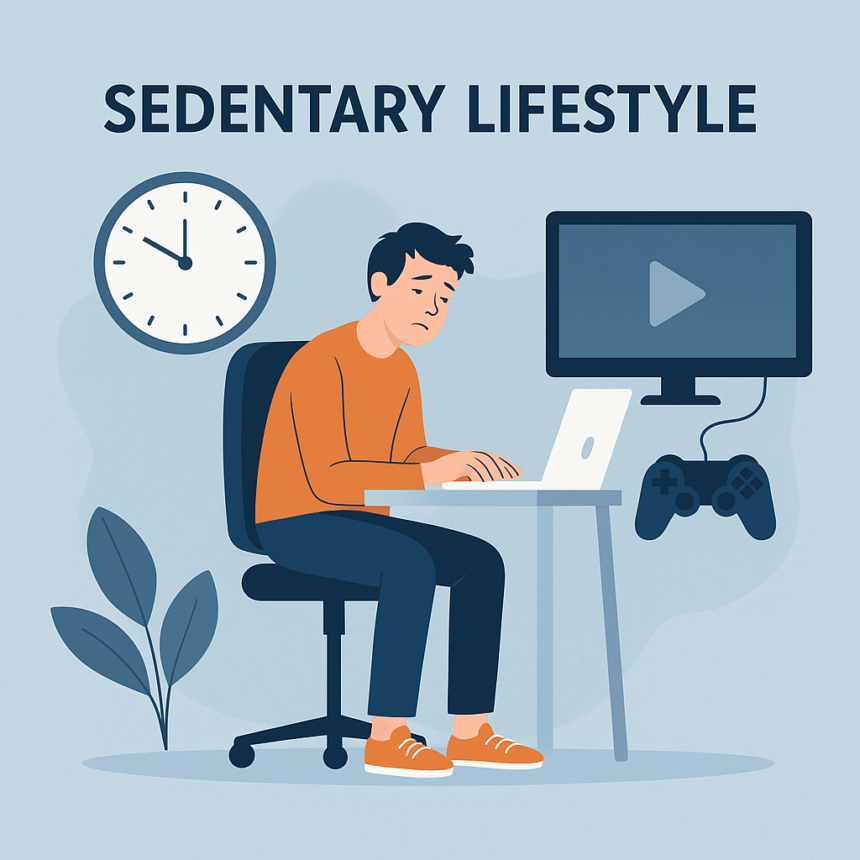In today’s fast-paced digital world, convenience and technology have brought comfort to our lives—but they’ve also given rise to a silent and dangerous habit: the sedentary lifestyle. Characterized by prolonged periods of sitting or minimal physical activity, this lifestyle is now one of the leading contributors to a variety of health issues across the globe.
In this blog post, we’ll explore what a sedentary lifestyle is, its causes, the health risks associated with it, and most importantly, how to combat it effectively.
What is a Sedentary Lifestyle?
Living a sedentary lifestyle means participating in minimal physical movement or exercise throughout the day. This often means sitting or lying down for most of the day with little to no exercise. Common activities that promote sedentary behavior include:
-
Watching television
-
Working long hours at a desk
-
Playing video games
-
Excessive smartphone or computer usage
-
Driving for extended periods
According to the World Health Organization (WHO), over 60-85% of people in the world—both from developed and developing countries—lead sedentary lives.
Causes of a Sedentary Lifestyle
Several factors have contributed to the rise of this lifestyle, including:
1. Technology Dependence
With smartphones, smart TVs, remote controls, and delivery apps, people can perform daily tasks with minimal movement.
2. Work Culture
Many jobs now involve desk work, and long hours in front of computers have become the norm.
3. Urban Living
Urban environments often lack green spaces or safe areas for walking, cycling, or outdoor activities.
4. Transportation Habits
Increased use of cars or public transport, even for short distances, reduces opportunities for walking or cycling.
Health Risks of a Sedentary Lifestyle
A sedentary lifestyle is linked to numerous physical and mental health issues. Here are some of the major concerns:
1. Obesity
Physical inactivity is a major contributor to weight gain and obesity, which can lead to numerous other health complications.
2. Cardiovascular Diseases
Sitting for long hours can increase the risk of high blood pressure, heart disease, and poor blood circulation.
3. Type 2 Diabetes
Prolonged inactivity affects how the body regulates blood sugar, increasing the risk of insulin resistance.
4. Muscle Weakness and Poor Posture
Lack of movement leads to weakened muscles and joints, often resulting in back pain and poor posture.
5. Mental Health Issues
Sedentary behavior is linked to increased feelings of stress, anxiety, and depression
6. Early Death
Studies show that being sedentary for more than eight hours a day without engaging in physical activity poses a mortality risk similar to that associated with smoking or obesity.
Warning Signs You Might Be Too Sedentary
-
You feel tired or sluggish most of the day.
-
You experience frequent back or neck pain.
-
Your weight has increased steadily over time.
-
You rarely engage in physical activity or exercise.
-
You spend hours watching TV or on screens without movement breaks.
How to Overcome a Sedentary Lifestyle
The good news is that you can break free from a sedentary lifestyle with small, consistent changes. Here’s how:
1. Incorporate Movement Into Your Day
-
Stand or stretch every 30 minutes.
-
Use a standing desk or take walking meetings.
-
Do short exercises during TV commercials.
2. Prioritize Regular Exercise
-
Try to get a minimum of 150 minutes of moderate aerobic exercise or 75 minutes of intense physical activity each week.
-
Add strength training exercises twice a week.
3. Change Your Commute
-
Walk or cycle instead of driving if possible.
-
Park further away to increase your step count.
4. Limit Screen Time
-
Set screen time limits for entertainment.
-
Use productivity tools to avoid binge-watching or mindless scrolling.
5. Use Fitness Trackers
Devices like smartwatches can motivate you to meet daily step goals and remind you to move.
The Role of Employers and Schools
Combatting sedentary behavior also requires a societal approach:
-
Employers can offer flexible workspaces, wellness programs, and active breaks.
-
Schools can include physical education, outdoor play, and movement-based learning activities.
Final Thoughts
A sedentary lifestyle is more than just a lack of exercise—it’s a health risk that needs immediate attention. The key lies in awareness and action. By incorporating more movement into our routines and encouraging an active culture in workplaces and homes, we can combat the dangers of prolonged inactivity.








